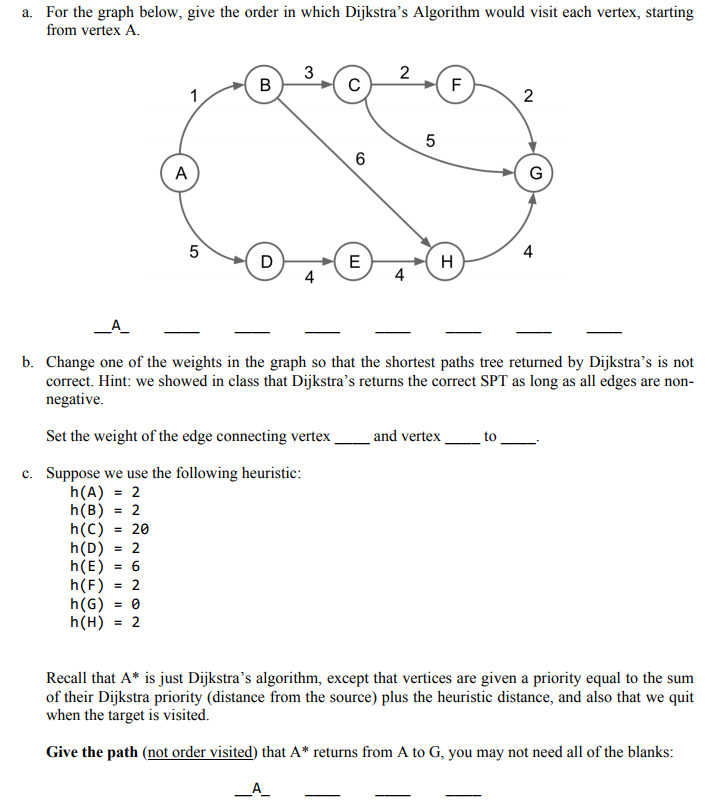For the graph below, give the order in which Dijkstra's Algorithm would visit each vertex, starting from vertex A. 3 2 B F 1 A G 5 4 D E H 4 4 2. CO
For the graph below, give the order in which Dijkstra's Algorithm would visit each vertex, starting from vertex A. 3 2 B F 1 A G 5 4 D E H 4 4 2. CO
Database System Concepts
7th Edition
ISBN:9780078022159
Author:Abraham Silberschatz Professor, Henry F. Korth, S. Sudarshan
Publisher:Abraham Silberschatz Professor, Henry F. Korth, S. Sudarshan
Chapter1: Introduction
Section: Chapter Questions
Problem 1PE
Related questions
Question

Transcribed Image Text:a. For the graph below, give the order in which Dijkstra’s Algorithm would visit each vertex, starting
from vertex A.
3
2
B
F
A
G
4
( E
4
D
H
4
b. Change one of the weights in the graph so that the shortest paths tree returned by Dijkstra's is not
correct. Hint: we showed in class that Dijkstra’s returns the correct SPT as long as all edges are non-
negative.
Set the weight of the edge connecting vertex .
and vertex
to
c. Suppose we use the following heuristic:
h(A) = 2
h(B) = 2
h(C) = 20
h(D) = 2
h(E) = 6
h(F) = 2
h(G) = 0
2
%3D
h(H)
%3D
Recall that A* is just Dijkstra’s algorithm, except that vertices are given a priority equal to the sum
of their Dijkstra priority (distance from the source) plus the heuristic distance, and also that we quit
when the target is visited.
Give the path (not order visited) that A* returns from A to G, you may not need all of the blanks:
_A_
2.
Expert Solution
This question has been solved!
Explore an expertly crafted, step-by-step solution for a thorough understanding of key concepts.
This is a popular solution!
Trending now
This is a popular solution!
Step by step
Solved in 2 steps

Knowledge Booster
Learn more about
Need a deep-dive on the concept behind this application? Look no further. Learn more about this topic, computer-science and related others by exploring similar questions and additional content below.Recommended textbooks for you

Database System Concepts
Computer Science
ISBN:
9780078022159
Author:
Abraham Silberschatz Professor, Henry F. Korth, S. Sudarshan
Publisher:
McGraw-Hill Education

Starting Out with Python (4th Edition)
Computer Science
ISBN:
9780134444321
Author:
Tony Gaddis
Publisher:
PEARSON

Digital Fundamentals (11th Edition)
Computer Science
ISBN:
9780132737968
Author:
Thomas L. Floyd
Publisher:
PEARSON

Database System Concepts
Computer Science
ISBN:
9780078022159
Author:
Abraham Silberschatz Professor, Henry F. Korth, S. Sudarshan
Publisher:
McGraw-Hill Education

Starting Out with Python (4th Edition)
Computer Science
ISBN:
9780134444321
Author:
Tony Gaddis
Publisher:
PEARSON

Digital Fundamentals (11th Edition)
Computer Science
ISBN:
9780132737968
Author:
Thomas L. Floyd
Publisher:
PEARSON

C How to Program (8th Edition)
Computer Science
ISBN:
9780133976892
Author:
Paul J. Deitel, Harvey Deitel
Publisher:
PEARSON

Database Systems: Design, Implementation, & Manag…
Computer Science
ISBN:
9781337627900
Author:
Carlos Coronel, Steven Morris
Publisher:
Cengage Learning

Programmable Logic Controllers
Computer Science
ISBN:
9780073373843
Author:
Frank D. Petruzella
Publisher:
McGraw-Hill Education